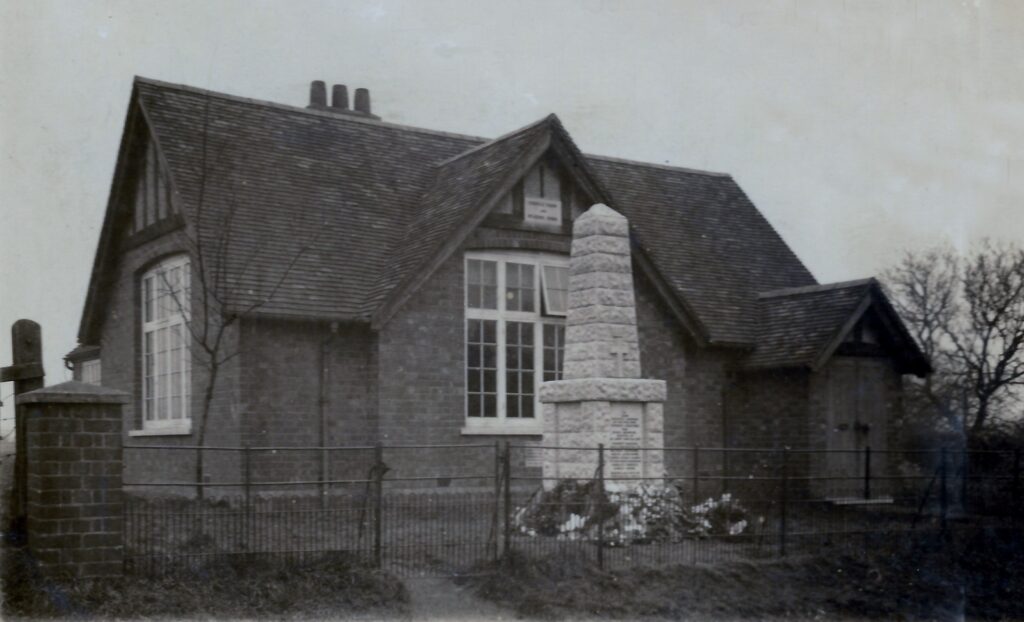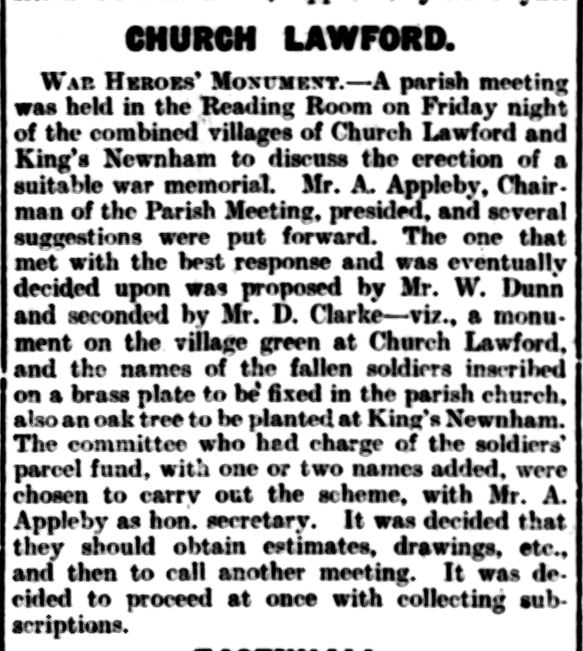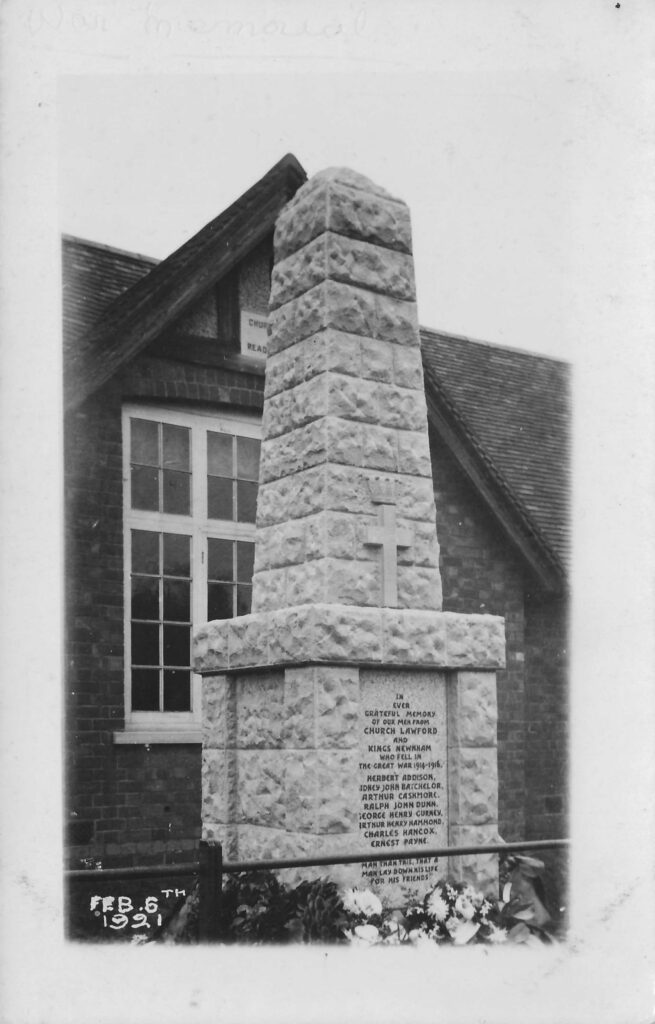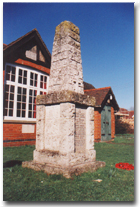The Village War Memorial was initially dedicated to those who had lost their lives in World War One. It was discussed almost as soon as the conflict as ended, with initial discussions favouring a site on the village green.


The final site chosen was outside the Reading Room, which itself had been opened shortly before the outbreak of the Great War. The postcard, shown below, was produced to record the completed memorial on dedication day.
The Rugby Advertiser carried a report on the dedication ceremony, held on 6th February 1921, as follows:

On Sunday afternoon a very interesting ceremony, and one that will be remembered with pride by many, took place in this village. As is usual in a good many things, the two villages. Church Lawford and King’s Newnham, amalgamated, and their joint efforts came to a successful issue on Sunday, when a memorial stone, which has been erected to the fallen lads of the two villages, was unveiled.
A short special service was conducted by the Rector, the Rev. H. Smith, during which the hymns, “Onward, Christian Soldiers,” ”O God, our help in ages past,” and ”For all Thy saints who from their labours rest,” were sung. Practically the whole of the villagers were present, including about 20 ex-service men, and several from the neighbouring villages. The ex-Service men were drawn up on two sides of the stone, with relations of the fallen and the choir on the third side, leaving the front open.
Ex-C.Q.M.-Sergt. C. H. Whiteman, who is a native of Church Lawford and also senior N.C.O. of the local men, had been asked to unveil the memorial, and as he took his place to do this, he said:—” I am proud to have been honoured by your Committee, who have asked me to unveil this beautiful memorial, which will stand for generations to remind us and those that come after us, that the men from the parishes of Church Lawford and Kings Newnham were ready and did come forward at the call of their country in August, 1914—all of them ready, if need be, to make the supreme sacrifice in the cause of right. I unveil this memorial to the grateful memory of the men from Church Lawford and Kings Newnham who fell in the great war.” He thereupon pulled the cord and released the Union Jack with which it had been covered.
Sergt. Whiteman then called out the names of the fallen soldiers, and at each name the relatives or friends came forward and placed a wreath on the stone to their memory. Several other wreaths were brought, including one from the ex-Service men.
Dr. Abraham, M.C., of Brandon, also gave a short address.
During the service the brothers Shelley, buglers, of Rugby Howitzer Battery, sounded the ” Last Post ” and ” Reveille.”
The memorial, which has been erected inside the grounds in front of the Reading Room, is in the form of an obelisk of rough Portland stone, four feet square at the base, and tapering up to eleven feet in height At the base of the pinnacle are carved a cross and crown just over the front panel of the base, which is in grey Cornish stone, and into which the following has been inserted in raised lead letters :—“ In ever grateful memory of our men from Church Lawford and Kings Newnham who fell in the great war, 1914-1918. Herbert Addison, Sidney John Batchelor, Arthur Cashmore, Ralph John Dunn, George Henry Gurney, Arthur Henry Hammond, Charles Hancox, Ernest Payne. Greater love hath no man than this that a man lay down his life for his friends.”
The work of the memorial, which has given every satisfaction to the committee and all concerned, has been executed by Mr. F. Oldham, of Coventry, at a cost of about £128, which has been raised by subscriptions.
Those Remembered on the Memorial
Herbert Addison was born in 1895 at Catthorpe, the eldest child of William and Lois Addison. According to the 1911 census, Herbert was 15 at this time, they were living at Brandon and he was already a farm labourer. He now had two sisters, Ethel and Amy, and two brothers Frank and Percy. At the time Herbert enlisted the family were living in Kings Newnham. Herbert, when he was killed in on 13th May 1917, aged 21. He was a soldier of the 2nd Battalion Royal Warwickshire, and died fulfilling the role of stretcher bearer.
Sydney John Batchelor was a Sergeant in the 1st Battalion of the Royal Warwickshire Regiment and he was 28 years old when he died in 1917. He is buried in Duisans British Cemetery, Etrun. He was the brother of Lucy Batchelor, who was well known to many villagers as the school cook – Lucy Ingram.
Arthur Cashmore also died in the Battle of the Somme on 3rd July 1916. Arthur had lived, worked and worshipped in Church Lawford, before enlisting with the 10th Service Battalion of the Royal Warwickshire Regiment in 1915. He died on the third day of the conflict.
Ralph John Dunn was the son of William and Mary Dunn who were based at Manor Farm in Kings Newnham from early in the 20th Century. He was in the Warwickshire Yeomanry with a rank of Second Lieutenant, and died on 24th September 1915 in Belgium, and is commemorated on the Loos Memorial.
The Battle of the Somme started on 1 July 1916. By the end of the battle, in November, 420,000 British men had died. In that July four men from Church Lawford and King’s Newnham lost their lives.
George Henry Gurney was born in Wolston to Harry and Clara Gurney. The family lived in Church Lawford in the early 1900’s where George was a farm labourer. He had four siblings, Frederick, Herbert, Gwendoline and Reginald. He served in the 10th Battalion Royal Warwickshire Regiment and died on 30 July 1916.
Arthur Henry Hammond served in the 2nd Battalion Royal Warwickshire Regiment, and was killed in action on the first day of the Battle of the Somme on 1st July 1916. He was born in Preston Capes in Northamptonshire and enlisted in Rugby being a resident of Long Lawford.
Charles Hancox was one of the first villagers to join up shortly after the war started. A Farm Labourer from Kings Newnham, he was the son of William and Sarah Hancox, born in 1891, He joined the Royal Warwickshire Regiment (First Battalion), and was killed on 26th April 1915, and his memorial is on the Menin Gate in Ypres.
Ernest Payne was born in Pailton in 1885. At aged 16 he was a stockman living at Shilton Fields. In 1907 he married Sarah Florence Mason and by 1911 he had become a waggoner, living at Fennis Fields, King’s Newnham, with their son Stanley, aged 2. He enlisted with the 11th Battalion Royal Warwickshire Regiment and was aged 31 when he was killed in action on 15 July 1916. Ernest is also remembered on the war memorial in Pailton.

Following the Second World War, two names were added to a lower face on the village War Memorial:
Sidney Phillip Cross was born in Woodstock, Oxfordshire and lived for a while with his family in Lawford Lodge Cottages, going to school in Church Lawford, working in Wolston once he turned 15, before the family moved to Binley. He died at the battle of Arnhem in September 1944, aged 20.
Sidney Joseph Smith succumbed to his wounds on 3rd April 1946 aged 25. He was the son of Thomas and Mary Louisa Smith, who lived in one of the cottages at the top of Church Road in Church Lawford. He served as a Lance Corporal rifleman in the London Irish Rifles, and is buried in a war grave near Florence in Italy.
